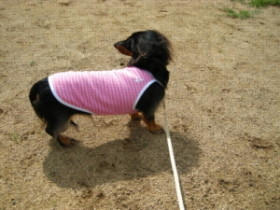
Each visually impaired dog has different difficulties.
Eye condition, such as one-sided blindness, amblyopia (low visual acuity), complete blindness, and process of vision loss produce different fears in dogs.
Dogs having vision in only one eye can’t detect objects in the side of the eye losing vision. So they can feel that objects pop up out of nowhere and get a scare. They may unintentionally get too close to other dogs. And it’s difficult for them to measure the distance from other dogs and people. It’s natural to bark, step back and growl in surprise and alarm.
Low-vision dogs see the dim shape of objects. We might look like ghost. They can’t identify what the object is but it come close to them. It’s like horror movie. It’s very scary! Even if they can recognize the object as a dog or person, they can’t clearly understand the dog’s/person’s expressions and body language. So they have extreme difficulty imagining their feelings and purpose to come close. A low-vision dog doesn’t make out whether the person coming to her tries to pass over, pet or grab her. With only one eye, it’s difficult to measure exact distance from other dogs and people. These build up anxiety in dogs. It is no wonder that they take the first move (show aggressive behaviors) to defend themselves.
Dogs’ first choice to recognize and identify objects and understand their situation is sense of vision but not their great noses. Even if their eyes don’t function well, sense of vision is still their first choice. As long as a dog can see, even she can hardly see, she tries to see and it’s hard to find to use other abilities as a substitute for her eyes.
Becoming entirely blind is very scary and inconvenient because of losing the most important tool to gather information to ensure the safety and move at ease. But there is the positive side. Totally-blind dogs face no choice but to make use of other abilities than sense of vision. They can find to use remaining abilities and develop them much easier than dogs having some vision.
They collect new information with remaining abilities, associate each object with feature except visual clue, such as its sound, texture, smell, through experiences, and store in their memory. They become able to create and use 3D mind maps of familiar places, such as their house and yard, including information of hight, measure the distance and direction by sounds and guess other dogs and people’s feelings from their breathing. If we can create and offer secure environment for them, they show us outstanding level of concentration to learn because they aren’t distracted by visual stimuli.
Dogs born without eyesight have no or little fear of blindness because the body condition is normal for them and they doesn’t lose anything. But other dogs are very confused and stressed from losing their eyesight. Even more, if it arise suddenly, such as from an accident and SARDs (Sudden Acquired Retinal Degeneration), blindness would make dogs experience overwhelming fear. When a blind dog gets panicky or be under intense stress from extreme fear, she would need the help of medication and you should talk to your vet.
Dogs can adapt to new body condition and no-visual-information world due to their great patience and flexibility but need time. We can not only give enough time (just wait) but also help a blind dog by force-free positive reinforcement training exercises and games to remind themselves to utilize their remaining abilities as new ways to do and get what they want, and develop the abilities and their self-confidence. Also positive reinforcement training can build interactive communication and better relationship between dogs and their owners, which cause dogs’ comfortable life.
Those who overly feel sorry for their dogs and focus on the negative side tend to do anything instead of blind dogs. Of course, protecting dog’s health and safety is our critical task. But too much help means to rob opportunities to display a blind dog great abilities, solve problems by herself and fun to discover something new. Those are important learning experiences to increase what a dog can do by herself and build self-confidence and self-control.
Blind dogs lost their eyesight but not curiosity. They have great abilities, senses of smell, touching and hearing, memory, imagination, creativity and intelligence! We can choose and offer appropriate and minimum help to make a blind dog feel more comfortable and improve her life by understanding an individual blind dog’s difficulties, feelings and great abilities.
Here are some examples of training exercises and games for blind dogs:
The followings are recommended to all types of blind dogs
Using “Notice Cue” to let a blind dog know what is going to happen
Free tutorial ebook (handout, pdf) is available from here.
Teaching hand targeting using finger snapping
Nose game using KONGs
Retrieve game using Oball rattle
Teaching and using sound signals
The followings are especially recommended to dogs getting scared to be touched
Teaching tricks by using touch as a prompt or cue. Being touched can turn into a sign of good things to come through repeatedly experiencing getting reward after being touched.
Trick “Spin”
Trick “Raising paw”
4 tricks using touch cues
Teaching tricks to voluntarily touch to people or object
Trick “Putting the chin on the palm”




No comments yet.